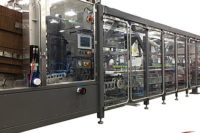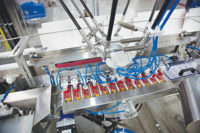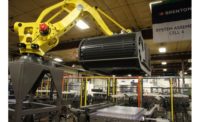As with other types of equipment used by bakers and snack manufacturers, robotics continues to drive innovation in stackers and loaders. The technology offers flexible automation capabilities that can handle variations in package sizes and customized orders prevalent in today’s marketplace. In addition, robotic end-of-arm tooling (EOAT) is keeping pace with software advances, which further enhances flexibility on the production line.
Demand for high-speed machinery with more flexibility and smaller footprints will continue to grow in the baking and snack industries. This, in turn, will spur demand for vision-guided, robotic pick-and-place systems and all-in-one machines that can do more in less space.
Mechanical stackers and loaders were once the only option for bakers and snack producers; with the rise of robotics end users now have a choice. “Typically, a robotic solution provides greater efficiency, is gentler on the product and allows for higher production speeds,” says Jerry Buckley, Midwest regional sales manager, BluePrint Automation Inc., Colonial Heights, VA. “We see a trend toward more robotic solutions for stacking and loading. As plant managers become more knowledgeable and comfortable with robotics, this trend will escalate.”
Robotic stacking and loading systems also enable manufacturers to accept products in random orientation from a delivery belt by integrating the line with a vision system. Together, these systems offer more versatility and reduce breakage because products do not need to be touched. “Previously, products had to be guided into mechanical stackers, which increased the chance of breakage or deformity,” Buckley explains.
“Robotics is not only inherently flexible, but it also is becoming less complex and costly to deploy in many applications,” says Scott M. Reed, vice president, sales, marketing and customer service, ADCO Manufacturing, Sanger, CA. “Customers are no longer afraid of robotics. Instead, they are embracing it and looking for ways to employ it in various applications.”
Robotic flexibility
From loading shippers to palletizing to handling new case designs and product packaging, robotic stackers and loaders bring many benefits to bakers’ and snack manufacturers’ production floors.
The ability to load multiple shippers in one packaging machine is a key feature of robotic systems, says John Keane, engineering product manager for packaging and distribution, AMF Bakery Systems, Richmond, VA. For example, dual-layering product into corrugated cardboard shippers with U-board insertion (to protect the bottom layer) can be handled by a robotic loader.
AMF Bakery Systems offers an Articulating Arm Basket Loader (ABL) that features controlled collation of soft products at high line speeds, the ability to load multiple shippers and automated changeover from product to product and/or shipper to shipper, Keane notes. EOAT design and programming limits the number of changeover requirements, and a programmable logic controller (PLC) reduces the need for programmer training and support.
Robotic stacking and loading systems can also complement conventional palletizing, says Matt Wicks, vice president, product development, manufacturing systems, Intelligrated, Mason, OH. “Hybrid palletizing machines combine the best of both worlds, offering the flexibility of the robot, while leveraging the speeds of a conventional palletizer,” he adds.
Intelligrated recently introduced a robotic “stack and wrap” integrated robotic palletizing and load wrapping cell to address challenges with pallet load stability, as well as the need to update patterns more frequently. IntelliGen software allows operators to create and update stacking patterns quickly and easily.
The latest stacking and loading equipment also needs to handle case designs that are constantly evolving as manufacturers look for ways to improve product visibility, increase case strength for product protection, and reduce materials and costs. “Often, these designs necessitate a machine capable of packaging goods into a variety of case/tray shapes and sizes,” says Craig Friesen, product manager, rigid business, Thiele Technologies Inc., Minneapolis. “Innovative designs are necessary to keep the machinery simple to operate and maintain without sacrificing flexibility.”
Thiele Technologies has developed robotic loading systems that handle products in flexible packaging, such as pouches and bags. The systems use EOAT and case-handling techniques that allow for difficult products to be accumulated, stacked and loaded into a case or tray. A robotics vision system identifies the product as it arrives randomly on a conveyor and manipulates it into a uniform pattern in the case, eliminating or reducing the need to align the product before introducing it to the packaging line.
ADCO Manufacturing recently introduced the ADCO EnCompass Wrap Around Case Packer (WACP). “Wraparound cases offer up to 30 percent material savings over traditional case styles, such as regular slotted containers (RSC),” says Reed. Also, they can create tighter packs with increased product protection. Designed to operate in demanding, space-conscious production environments, WACP handles a wide range of wraparound case sizes at speeds up to 20 cases per minute. It features an ergonomic magazine load height, dual-shaft design for easy setup and standard servo controls.”
Designing stackers and loaders for use in bakeries and snack food plants with limited floor space is challenging. An end-of-line packaging area originally designed as a manual operation typically does not have much floor space left to add automation because the area between the wrappers and truck dock is usually filled with product waiting to ship.
“The use of robotics for packaging, while possibly smaller than other options, still requires floor space that an existing plant may not have,” says Keane. “Thus, stacker/loader designs need to be highly flexible to fit into an existing plant. An articulating arm robot adapts well into such areas while maximizing functions.”
Changing conditions within a facility may contribute to a product that is inconsistent in size, which can be problematic if the product becomes too large to fit into its designated shipper. “Automation has not yet reached a level to accommodate per-bag changes in product dimensions,” Keane adds, “so tighter controls have to be placed upstream, prior to packaging, to prevent inconsistent product sizes from reaching the packaging area.”
Moving ahead
Efficient order picking and pallet-building are also important aspects of stacking and loading operations. To that end, Yale Materials Handling Corp., Greenville, NC, offers the Yale MO25 multi-level order selector. Available with a fixed or lifting platform with an independent forklift for first- and second-level picking, the MO25 pallet truck is suitable for cross-docking and load-shuttling, as well as order-picking in high-throughput warehouse operations and horizontal transport.
“A key piece of the puzzle in bakery and snack markets is protecting the product,” says Matt Barrow, product manager, Yale Materials Handling. “As businesses implement shelf-ready or reduced packaging designs for cost-cutting, marketing or sustainability reasons, they need pallet load stacking operations to move swiftly to hit throughput targets without compromising product integrity.”
Another consideration is space, especially in warehouses and production facilities near urban centers, where the cost of land keeps rising. “Rather than expand horizontally and buy extra space, facilities managers should strive to increase storage and stacking density—to fit more stacking and storage locations into the same area. Systems such as the MO25 can help in this area,” Barrow notes.
Fast cycle times and long production runs will always favor fixed automation, says Charles C. Gales, manager, automation sales, Weldon Solutions, York, PA, a system integrator for Fanuc Robotics. However, increased variation in package sizes and customized orders will lead to a greater reliance on flexible—typically robotic—automation.
“Robot and vision system controls will evolve so that robots will be able to reliably stack and load whatever product is presented,” Gales says. “In addition, EOAT design will keep pace with software advances, so robotic stacking and loading systems will become the choice for more bakers and snack producers in a variety of applications.”












